HNC Business: Accounting Management Report on Financial Systems
VerifiedAdded on 2021/05/28
|45
|14945
|460
Report
AI Summary
This report, submitted by a student, provides a comprehensive overview of accounting management. It begins by defining managerial accounting and tracing its origins to the industrial revolution, highlighting its role in providing internal financial analyses and supporting management decisions. The report then explores the roles of management accounting in developing financial strategies, explaining financial implications, and monitoring spending. It delves into key principles such as designing and compiling accounting data, and employing management by exception. The report further examines different accounting systems including inventory control, cost accounting, job costing, and price management. It differentiates between financial and management accounting, detailing their objectives, users, and reporting formats. The importance of relevant, reliable, and accurate information is emphasized, along with the need for information to be interpreted in a comprehensible manner. Finally, the report discusses various types of managerial accounting reports, such as budget reports and accounts receivable aging reports, used by small businesses to monitor performance and manage cash flow.
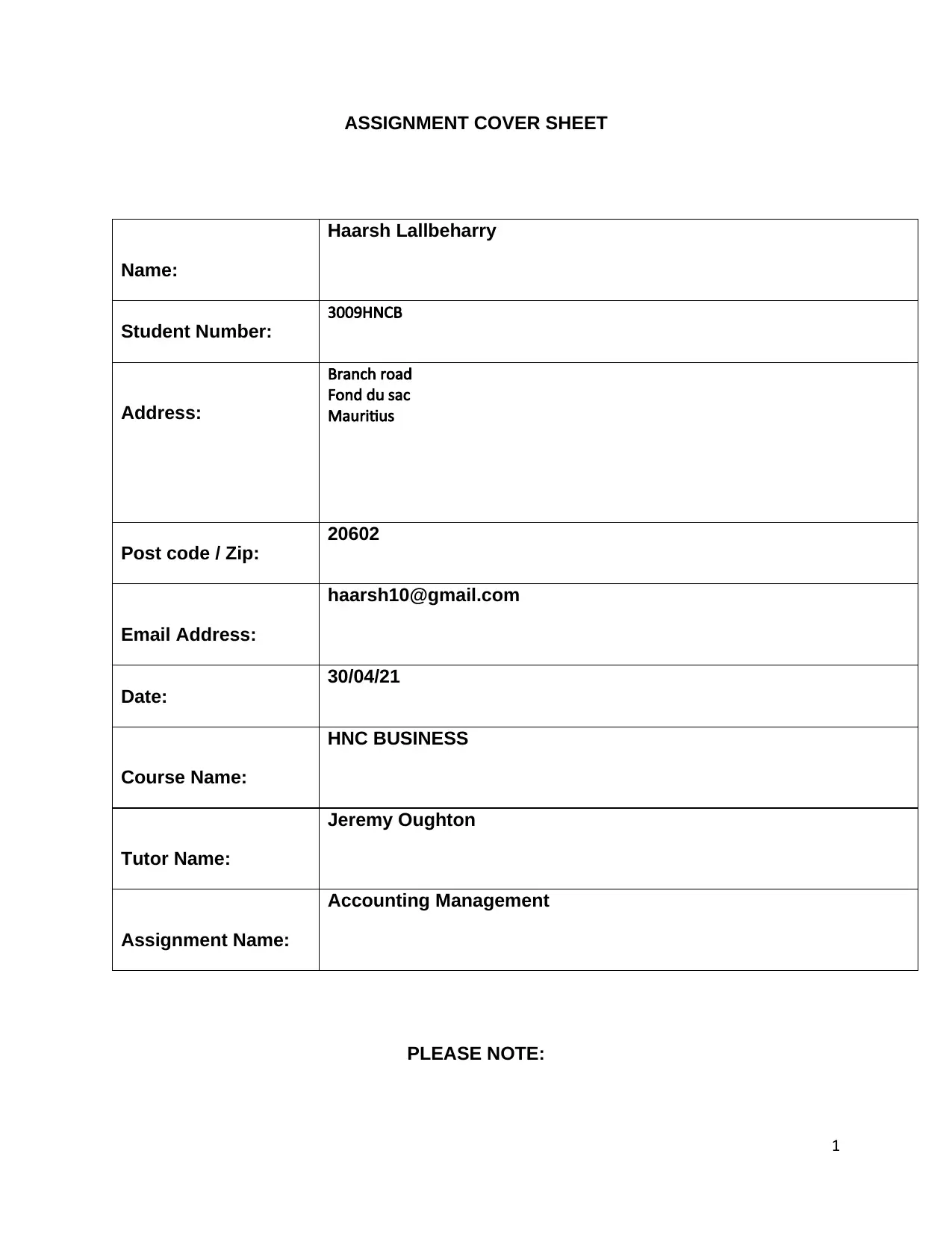
ASSIGNMENT COVER SHEET
Name:
Haarsh Lallbeharry
Student Number:
3009HNCB
Address:
Branch road
Fond du sac
Mauritius
Post code / Zip:
20602
Email Address:
haarsh10@gmail.com
Date:
30/04/21
Course Name:
HNC BUSINESS
Tutor Name:
Jeremy Oughton
Assignment Name:
Accounting Management
PLEASE NOTE:
1
Name:
Haarsh Lallbeharry
Student Number:
3009HNCB
Address:
Branch road
Fond du sac
Mauritius
Post code / Zip:
20602
Email Address:
haarsh10@gmail.com
Date:
30/04/21
Course Name:
HNC BUSINESS
Tutor Name:
Jeremy Oughton
Assignment Name:
Accounting Management
PLEASE NOTE:
1
Paraphrase This Document
Need a fresh take? Get an instant paraphrase of this document with our AI Paraphraser
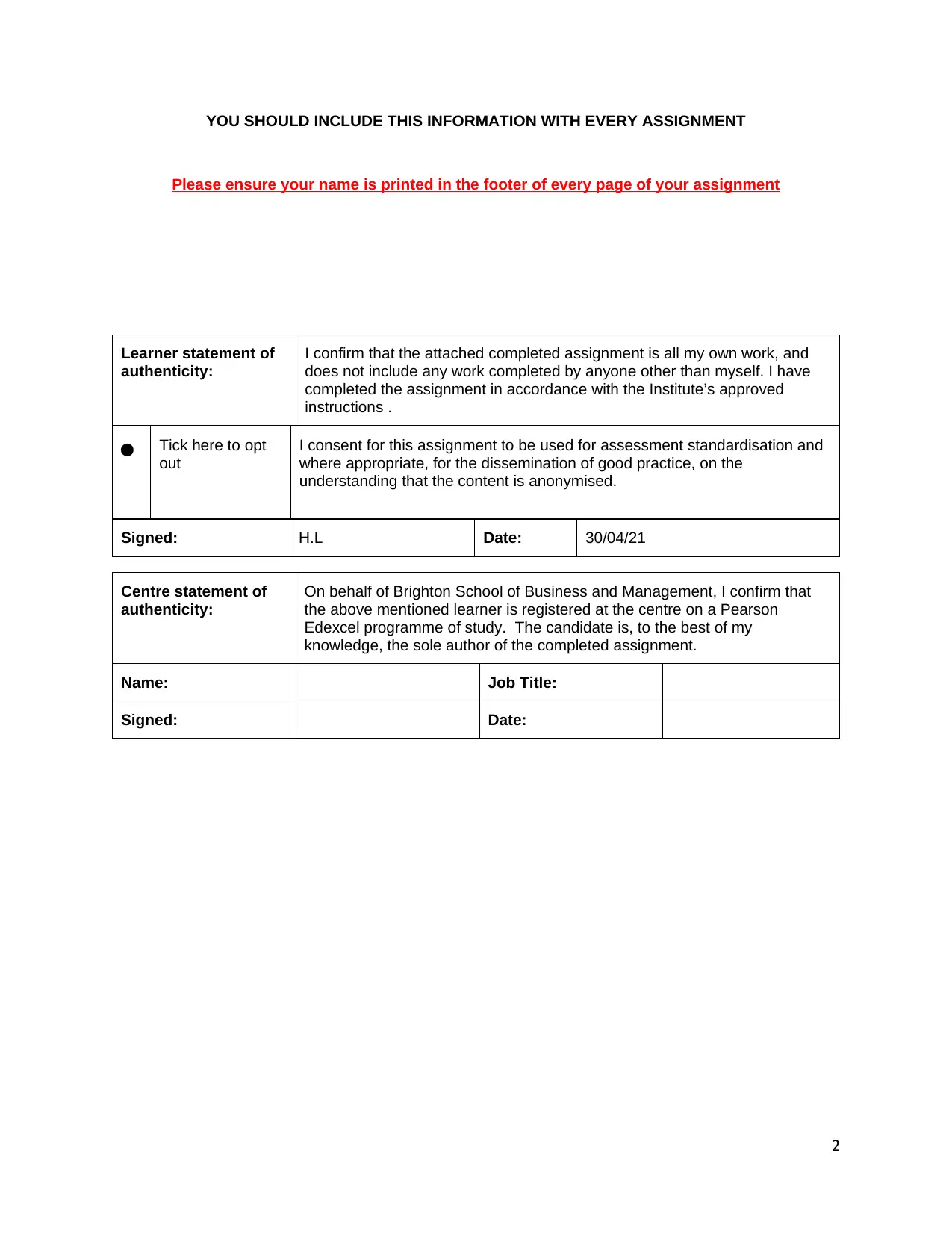
YOU SHOULD INCLUDE THIS INFORMATION WITH EVERY ASSIGNMENT
Please ensure your name is printed in the footer of every page of your assignment
Learner statement of
authenticity:
I confirm that the attached completed assignment is all my own work, and
does not include any work completed by anyone other than myself. I have
completed the assignment in accordance with the Institute’s approved
instructions .
Tick here to opt
out
I consent for this assignment to be used for assessment standardisation and
where appropriate, for the dissemination of good practice, on the
understanding that the content is anonymised.
Signed: H.L Date: 30/04/21
Centre statement of
authenticity:
On behalf of Brighton School of Business and Management, I confirm that
the above mentioned learner is registered at the centre on a Pearson
Edexcel programme of study. The candidate is, to the best of my
knowledge, the sole author of the completed assignment.
Name: Job Title:
Signed: Date:
2
Please ensure your name is printed in the footer of every page of your assignment
Learner statement of
authenticity:
I confirm that the attached completed assignment is all my own work, and
does not include any work completed by anyone other than myself. I have
completed the assignment in accordance with the Institute’s approved
instructions .
Tick here to opt
out
I consent for this assignment to be used for assessment standardisation and
where appropriate, for the dissemination of good practice, on the
understanding that the content is anonymised.
Signed: H.L Date: 30/04/21
Centre statement of
authenticity:
On behalf of Brighton School of Business and Management, I confirm that
the above mentioned learner is registered at the centre on a Pearson
Edexcel programme of study. The candidate is, to the best of my
knowledge, the sole author of the completed assignment.
Name: Job Title:
Signed: Date:
2
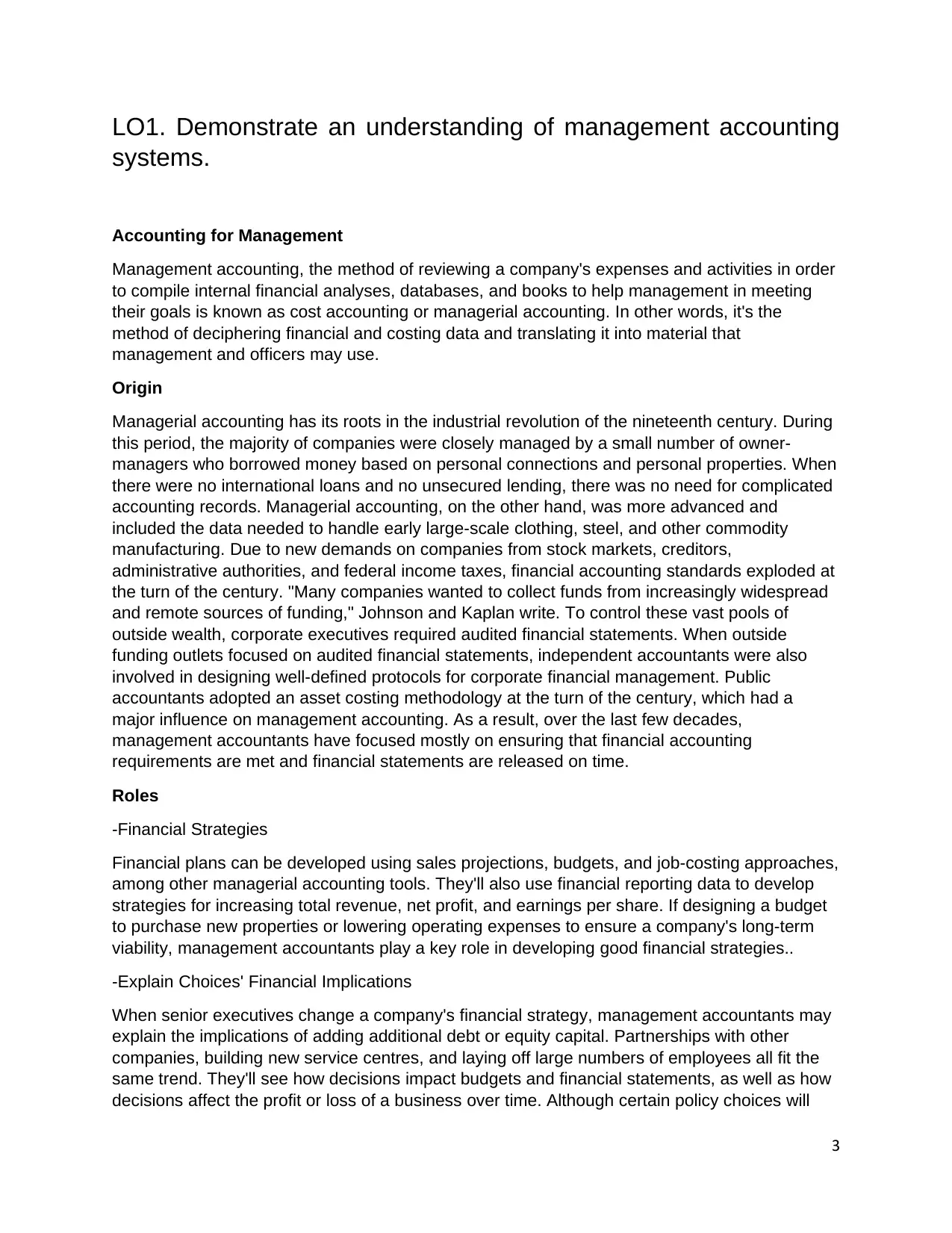
LO1. Demonstrate an understanding of management accounting
systems.
Accounting for Management
Management accounting, the method of reviewing a company's expenses and activities in order
to compile internal financial analyses, databases, and books to help management in meeting
their goals is known as cost accounting or managerial accounting. In other words, it's the
method of deciphering financial and costing data and translating it into material that
management and officers may use.
Origin
Managerial accounting has its roots in the industrial revolution of the nineteenth century. During
this period, the majority of companies were closely managed by a small number of owner-
managers who borrowed money based on personal connections and personal properties. When
there were no international loans and no unsecured lending, there was no need for complicated
accounting records. Managerial accounting, on the other hand, was more advanced and
included the data needed to handle early large-scale clothing, steel, and other commodity
manufacturing. Due to new demands on companies from stock markets, creditors,
administrative authorities, and federal income taxes, financial accounting standards exploded at
the turn of the century. "Many companies wanted to collect funds from increasingly widespread
and remote sources of funding," Johnson and Kaplan write. To control these vast pools of
outside wealth, corporate executives required audited financial statements. When outside
funding outlets focused on audited financial statements, independent accountants were also
involved in designing well-defined protocols for corporate financial management. Public
accountants adopted an asset costing methodology at the turn of the century, which had a
major influence on management accounting. As a result, over the last few decades,
management accountants have focused mostly on ensuring that financial accounting
requirements are met and financial statements are released on time.
Roles
-Financial Strategies
Financial plans can be developed using sales projections, budgets, and job-costing approaches,
among other managerial accounting tools. They'll also use financial reporting data to develop
strategies for increasing total revenue, net profit, and earnings per share. If designing a budget
to purchase new properties or lowering operating expenses to ensure a company's long-term
viability, management accountants play a key role in developing good financial strategies..
-Explain Choices' Financial Implications
When senior executives change a company's financial strategy, management accountants may
explain the implications of adding additional debt or equity capital. Partnerships with other
companies, building new service centres, and laying off large numbers of employees all fit the
same trend. They'll see how decisions impact budgets and financial statements, as well as how
decisions affect the profit or loss of a business over time. Although certain policy choices will
3
systems.
Accounting for Management
Management accounting, the method of reviewing a company's expenses and activities in order
to compile internal financial analyses, databases, and books to help management in meeting
their goals is known as cost accounting or managerial accounting. In other words, it's the
method of deciphering financial and costing data and translating it into material that
management and officers may use.
Origin
Managerial accounting has its roots in the industrial revolution of the nineteenth century. During
this period, the majority of companies were closely managed by a small number of owner-
managers who borrowed money based on personal connections and personal properties. When
there were no international loans and no unsecured lending, there was no need for complicated
accounting records. Managerial accounting, on the other hand, was more advanced and
included the data needed to handle early large-scale clothing, steel, and other commodity
manufacturing. Due to new demands on companies from stock markets, creditors,
administrative authorities, and federal income taxes, financial accounting standards exploded at
the turn of the century. "Many companies wanted to collect funds from increasingly widespread
and remote sources of funding," Johnson and Kaplan write. To control these vast pools of
outside wealth, corporate executives required audited financial statements. When outside
funding outlets focused on audited financial statements, independent accountants were also
involved in designing well-defined protocols for corporate financial management. Public
accountants adopted an asset costing methodology at the turn of the century, which had a
major influence on management accounting. As a result, over the last few decades,
management accountants have focused mostly on ensuring that financial accounting
requirements are met and financial statements are released on time.
Roles
-Financial Strategies
Financial plans can be developed using sales projections, budgets, and job-costing approaches,
among other managerial accounting tools. They'll also use financial reporting data to develop
strategies for increasing total revenue, net profit, and earnings per share. If designing a budget
to purchase new properties or lowering operating expenses to ensure a company's long-term
viability, management accountants play a key role in developing good financial strategies..
-Explain Choices' Financial Implications
When senior executives change a company's financial strategy, management accountants may
explain the implications of adding additional debt or equity capital. Partnerships with other
companies, building new service centres, and laying off large numbers of employees all fit the
same trend. They'll see how decisions impact budgets and financial statements, as well as how
decisions affect the profit or loss of a business over time. Although certain policy choices will
3
⊘ This is a preview!⊘
Do you want full access?
Subscribe today to unlock all pages.

Trusted by 1+ million students worldwide
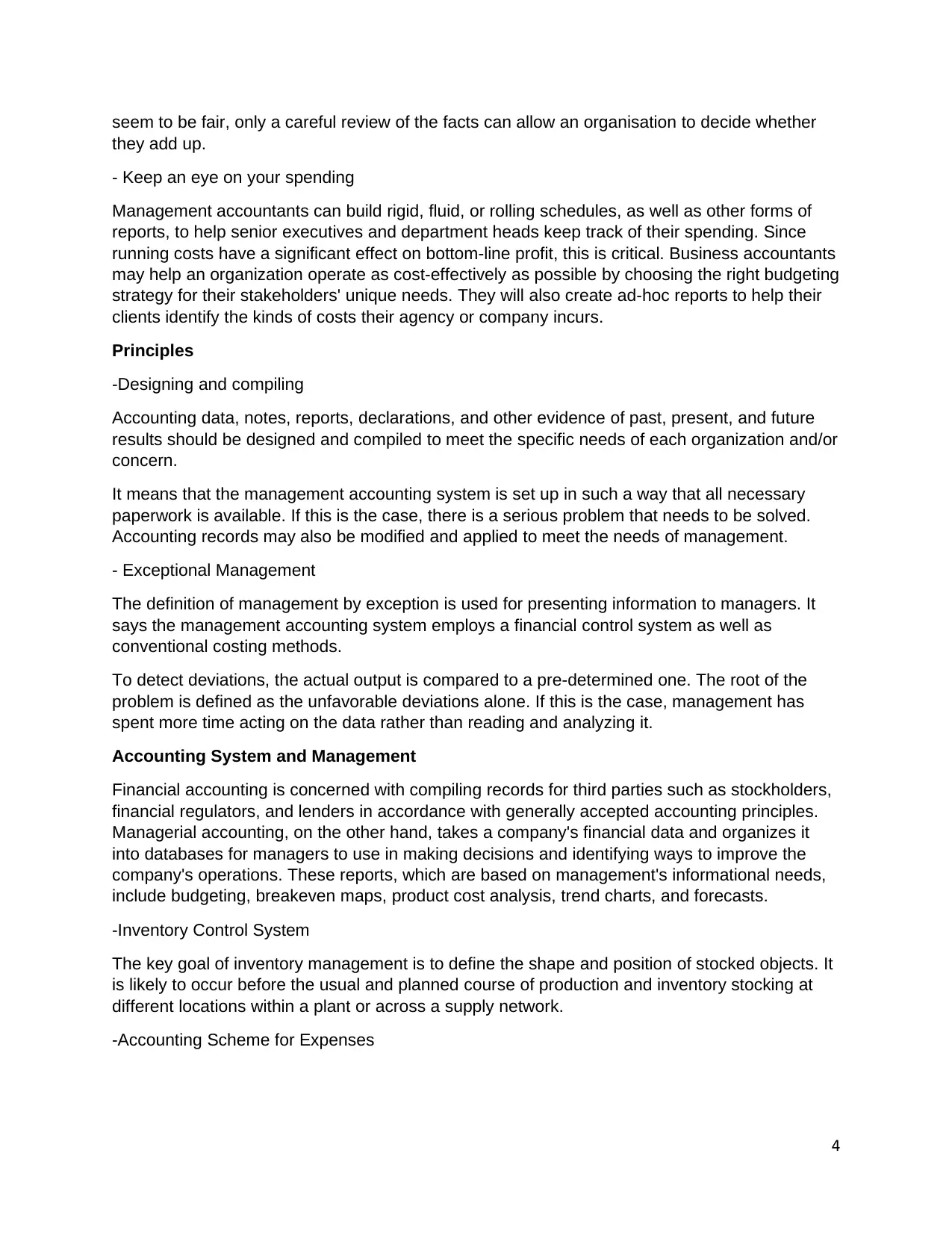
seem to be fair, only a careful review of the facts can allow an organisation to decide whether
they add up.
- Keep an eye on your spending
Management accountants can build rigid, fluid, or rolling schedules, as well as other forms of
reports, to help senior executives and department heads keep track of their spending. Since
running costs have a significant effect on bottom-line profit, this is critical. Business accountants
may help an organization operate as cost-effectively as possible by choosing the right budgeting
strategy for their stakeholders' unique needs. They will also create ad-hoc reports to help their
clients identify the kinds of costs their agency or company incurs.
Principles
-Designing and compiling
Accounting data, notes, reports, declarations, and other evidence of past, present, and future
results should be designed and compiled to meet the specific needs of each organization and/or
concern.
It means that the management accounting system is set up in such a way that all necessary
paperwork is available. If this is the case, there is a serious problem that needs to be solved.
Accounting records may also be modified and applied to meet the needs of management.
- Exceptional Management
The definition of management by exception is used for presenting information to managers. It
says the management accounting system employs a financial control system as well as
conventional costing methods.
To detect deviations, the actual output is compared to a pre-determined one. The root of the
problem is defined as the unfavorable deviations alone. If this is the case, management has
spent more time acting on the data rather than reading and analyzing it.
Accounting System and Management
Financial accounting is concerned with compiling records for third parties such as stockholders,
financial regulators, and lenders in accordance with generally accepted accounting principles.
Managerial accounting, on the other hand, takes a company's financial data and organizes it
into databases for managers to use in making decisions and identifying ways to improve the
company's operations. These reports, which are based on management's informational needs,
include budgeting, breakeven maps, product cost analysis, trend charts, and forecasts.
-Inventory Control System
The key goal of inventory management is to define the shape and position of stocked objects. It
is likely to occur before the usual and planned course of production and inventory stocking at
different locations within a plant or across a supply network.
-Accounting Scheme for Expenses
4
they add up.
- Keep an eye on your spending
Management accountants can build rigid, fluid, or rolling schedules, as well as other forms of
reports, to help senior executives and department heads keep track of their spending. Since
running costs have a significant effect on bottom-line profit, this is critical. Business accountants
may help an organization operate as cost-effectively as possible by choosing the right budgeting
strategy for their stakeholders' unique needs. They will also create ad-hoc reports to help their
clients identify the kinds of costs their agency or company incurs.
Principles
-Designing and compiling
Accounting data, notes, reports, declarations, and other evidence of past, present, and future
results should be designed and compiled to meet the specific needs of each organization and/or
concern.
It means that the management accounting system is set up in such a way that all necessary
paperwork is available. If this is the case, there is a serious problem that needs to be solved.
Accounting records may also be modified and applied to meet the needs of management.
- Exceptional Management
The definition of management by exception is used for presenting information to managers. It
says the management accounting system employs a financial control system as well as
conventional costing methods.
To detect deviations, the actual output is compared to a pre-determined one. The root of the
problem is defined as the unfavorable deviations alone. If this is the case, management has
spent more time acting on the data rather than reading and analyzing it.
Accounting System and Management
Financial accounting is concerned with compiling records for third parties such as stockholders,
financial regulators, and lenders in accordance with generally accepted accounting principles.
Managerial accounting, on the other hand, takes a company's financial data and organizes it
into databases for managers to use in making decisions and identifying ways to improve the
company's operations. These reports, which are based on management's informational needs,
include budgeting, breakeven maps, product cost analysis, trend charts, and forecasts.
-Inventory Control System
The key goal of inventory management is to define the shape and position of stocked objects. It
is likely to occur before the usual and planned course of production and inventory stocking at
different locations within a plant or across a supply network.
-Accounting Scheme for Expenses
4
Paraphrase This Document
Need a fresh take? Get an instant paraphrase of this document with our AI Paraphraser
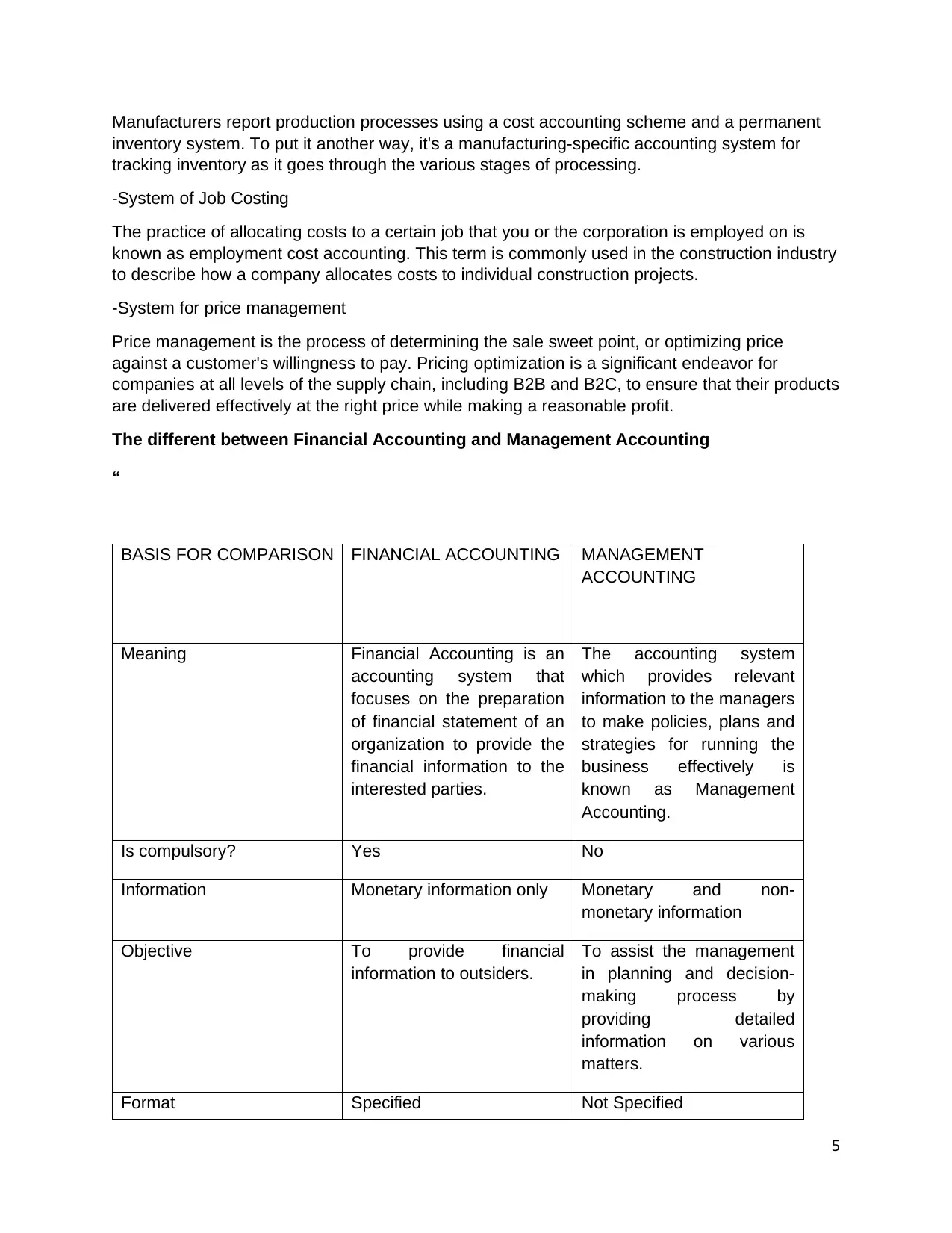
Manufacturers report production processes using a cost accounting scheme and a permanent
inventory system. To put it another way, it's a manufacturing-specific accounting system for
tracking inventory as it goes through the various stages of processing.
-System of Job Costing
The practice of allocating costs to a certain job that you or the corporation is employed on is
known as employment cost accounting. This term is commonly used in the construction industry
to describe how a company allocates costs to individual construction projects.
-System for price management
Price management is the process of determining the sale sweet point, or optimizing price
against a customer's willingness to pay. Pricing optimization is a significant endeavor for
companies at all levels of the supply chain, including B2B and B2C, to ensure that their products
are delivered effectively at the right price while making a reasonable profit.
The different between Financial Accounting and Management Accounting
“
BASIS FOR COMPARISON FINANCIAL ACCOUNTING MANAGEMENT
ACCOUNTING
Meaning Financial Accounting is an
accounting system that
focuses on the preparation
of financial statement of an
organization to provide the
financial information to the
interested parties.
The accounting system
which provides relevant
information to the managers
to make policies, plans and
strategies for running the
business effectively is
known as Management
Accounting.
Is compulsory? Yes No
Information Monetary information only Monetary and non-
monetary information
Objective To provide financial
information to outsiders.
To assist the management
in planning and decision-
making process by
providing detailed
information on various
matters.
Format Specified Not Specified
5
inventory system. To put it another way, it's a manufacturing-specific accounting system for
tracking inventory as it goes through the various stages of processing.
-System of Job Costing
The practice of allocating costs to a certain job that you or the corporation is employed on is
known as employment cost accounting. This term is commonly used in the construction industry
to describe how a company allocates costs to individual construction projects.
-System for price management
Price management is the process of determining the sale sweet point, or optimizing price
against a customer's willingness to pay. Pricing optimization is a significant endeavor for
companies at all levels of the supply chain, including B2B and B2C, to ensure that their products
are delivered effectively at the right price while making a reasonable profit.
The different between Financial Accounting and Management Accounting
“
BASIS FOR COMPARISON FINANCIAL ACCOUNTING MANAGEMENT
ACCOUNTING
Meaning Financial Accounting is an
accounting system that
focuses on the preparation
of financial statement of an
organization to provide the
financial information to the
interested parties.
The accounting system
which provides relevant
information to the managers
to make policies, plans and
strategies for running the
business effectively is
known as Management
Accounting.
Is compulsory? Yes No
Information Monetary information only Monetary and non-
monetary information
Objective To provide financial
information to outsiders.
To assist the management
in planning and decision-
making process by
providing detailed
information on various
matters.
Format Specified Not Specified
5
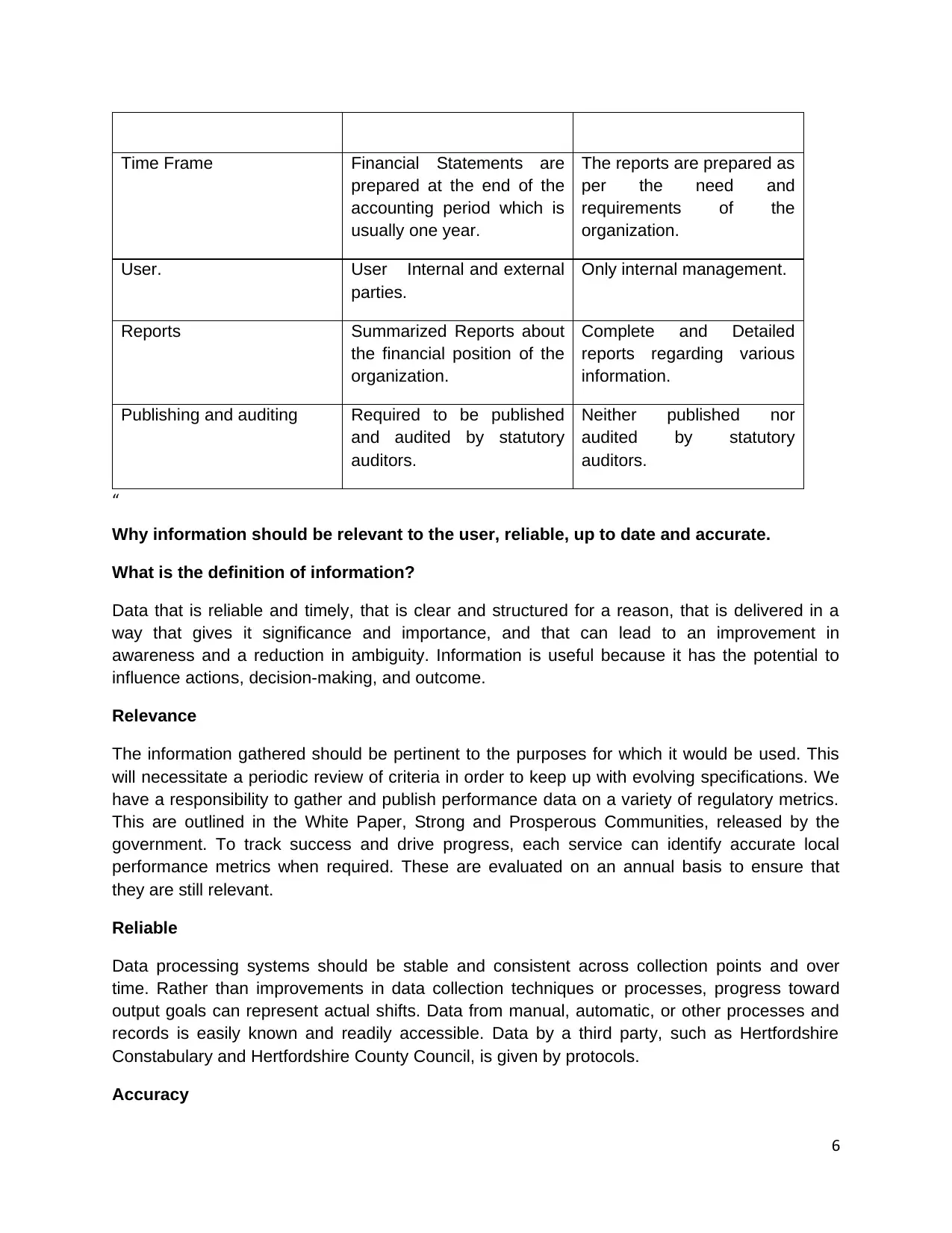
Time Frame Financial Statements are
prepared at the end of the
accounting period which is
usually one year.
The reports are prepared as
per the need and
requirements of the
organization.
User. User Internal and external
parties.
Only internal management.
Reports Summarized Reports about
the financial position of the
organization.
Complete and Detailed
reports regarding various
information.
Publishing and auditing Required to be published
and audited by statutory
auditors.
Neither published nor
audited by statutory
auditors.
“
Why information should be relevant to the user, reliable, up to date and accurate.
What is the definition of information?
Data that is reliable and timely, that is clear and structured for a reason, that is delivered in a
way that gives it significance and importance, and that can lead to an improvement in
awareness and a reduction in ambiguity. Information is useful because it has the potential to
influence actions, decision-making, and outcome.
Relevance
The information gathered should be pertinent to the purposes for which it would be used. This
will necessitate a periodic review of criteria in order to keep up with evolving specifications. We
have a responsibility to gather and publish performance data on a variety of regulatory metrics.
This are outlined in the White Paper, Strong and Prosperous Communities, released by the
government. To track success and drive progress, each service can identify accurate local
performance metrics when required. These are evaluated on an annual basis to ensure that
they are still relevant.
Reliable
Data processing systems should be stable and consistent across collection points and over
time. Rather than improvements in data collection techniques or processes, progress toward
output goals can represent actual shifts. Data from manual, automatic, or other processes and
records is easily known and readily accessible. Data by a third party, such as Hertfordshire
Constabulary and Hertfordshire County Council, is given by protocols.
Accuracy
6
prepared at the end of the
accounting period which is
usually one year.
The reports are prepared as
per the need and
requirements of the
organization.
User. User Internal and external
parties.
Only internal management.
Reports Summarized Reports about
the financial position of the
organization.
Complete and Detailed
reports regarding various
information.
Publishing and auditing Required to be published
and audited by statutory
auditors.
Neither published nor
audited by statutory
auditors.
“
Why information should be relevant to the user, reliable, up to date and accurate.
What is the definition of information?
Data that is reliable and timely, that is clear and structured for a reason, that is delivered in a
way that gives it significance and importance, and that can lead to an improvement in
awareness and a reduction in ambiguity. Information is useful because it has the potential to
influence actions, decision-making, and outcome.
Relevance
The information gathered should be pertinent to the purposes for which it would be used. This
will necessitate a periodic review of criteria in order to keep up with evolving specifications. We
have a responsibility to gather and publish performance data on a variety of regulatory metrics.
This are outlined in the White Paper, Strong and Prosperous Communities, released by the
government. To track success and drive progress, each service can identify accurate local
performance metrics when required. These are evaluated on an annual basis to ensure that
they are still relevant.
Reliable
Data processing systems should be stable and consistent across collection points and over
time. Rather than improvements in data collection techniques or processes, progress toward
output goals can represent actual shifts. Data from manual, automatic, or other processes and
records is easily known and readily accessible. Data by a third party, such as Hertfordshire
Constabulary and Hertfordshire County Council, is given by protocols.
Accuracy
6
⊘ This is a preview!⊘
Do you want full access?
Subscribe today to unlock all pages.

Trusted by 1+ million students worldwide
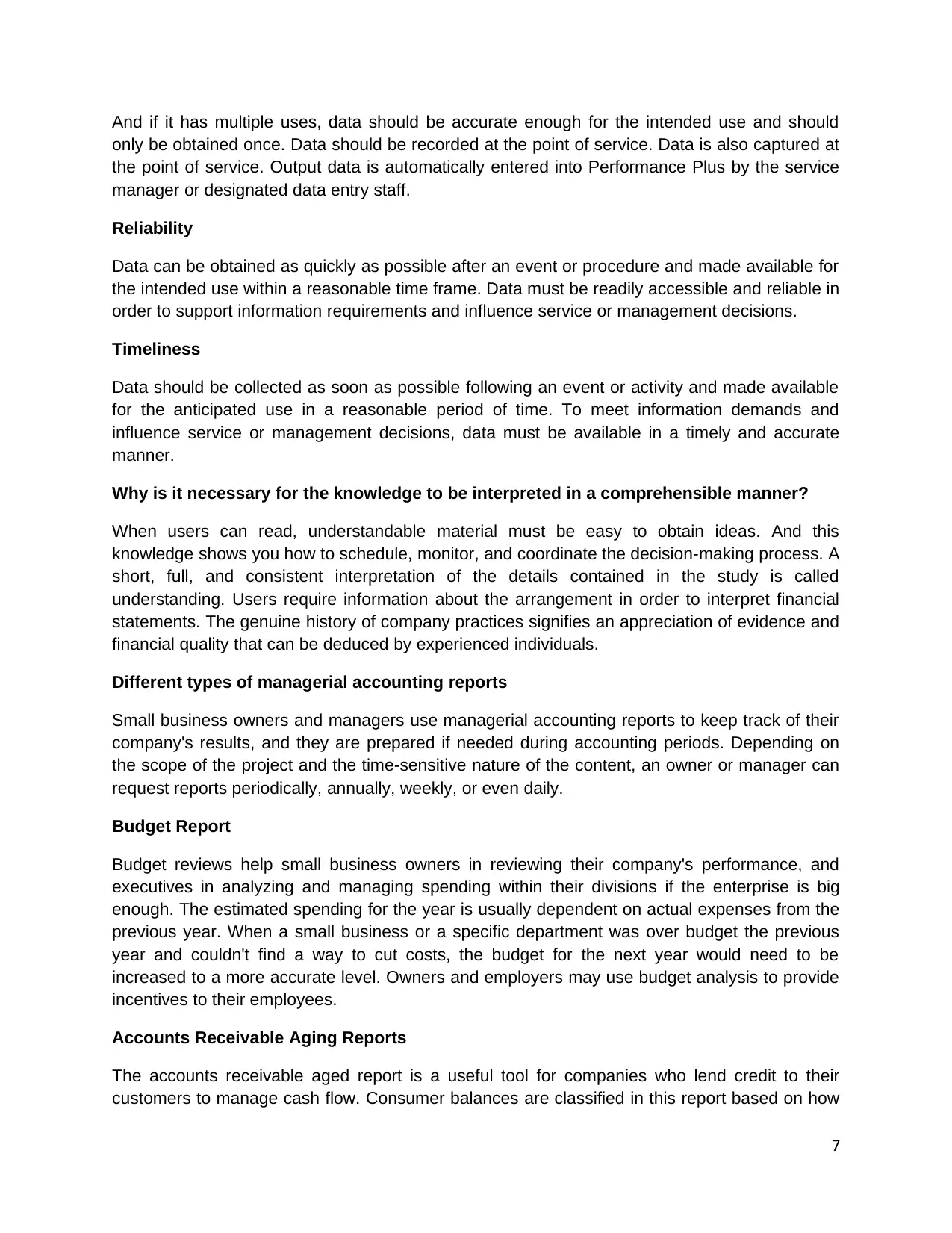
And if it has multiple uses, data should be accurate enough for the intended use and should
only be obtained once. Data should be recorded at the point of service. Data is also captured at
the point of service. Output data is automatically entered into Performance Plus by the service
manager or designated data entry staff.
Reliability
Data can be obtained as quickly as possible after an event or procedure and made available for
the intended use within a reasonable time frame. Data must be readily accessible and reliable in
order to support information requirements and influence service or management decisions.
Timeliness
Data should be collected as soon as possible following an event or activity and made available
for the anticipated use in a reasonable period of time. To meet information demands and
influence service or management decisions, data must be available in a timely and accurate
manner.
Why is it necessary for the knowledge to be interpreted in a comprehensible manner?
When users can read, understandable material must be easy to obtain ideas. And this
knowledge shows you how to schedule, monitor, and coordinate the decision-making process. A
short, full, and consistent interpretation of the details contained in the study is called
understanding. Users require information about the arrangement in order to interpret financial
statements. The genuine history of company practices signifies an appreciation of evidence and
financial quality that can be deduced by experienced individuals.
Different types of managerial accounting reports
Small business owners and managers use managerial accounting reports to keep track of their
company's results, and they are prepared if needed during accounting periods. Depending on
the scope of the project and the time-sensitive nature of the content, an owner or manager can
request reports periodically, annually, weekly, or even daily.
Budget Report
Budget reviews help small business owners in reviewing their company's performance, and
executives in analyzing and managing spending within their divisions if the enterprise is big
enough. The estimated spending for the year is usually dependent on actual expenses from the
previous year. When a small business or a specific department was over budget the previous
year and couldn't find a way to cut costs, the budget for the next year would need to be
increased to a more accurate level. Owners and employers may use budget analysis to provide
incentives to their employees.
Accounts Receivable Aging Reports
The accounts receivable aged report is a useful tool for companies who lend credit to their
customers to manage cash flow. Consumer balances are classified in this report based on how
7
only be obtained once. Data should be recorded at the point of service. Data is also captured at
the point of service. Output data is automatically entered into Performance Plus by the service
manager or designated data entry staff.
Reliability
Data can be obtained as quickly as possible after an event or procedure and made available for
the intended use within a reasonable time frame. Data must be readily accessible and reliable in
order to support information requirements and influence service or management decisions.
Timeliness
Data should be collected as soon as possible following an event or activity and made available
for the anticipated use in a reasonable period of time. To meet information demands and
influence service or management decisions, data must be available in a timely and accurate
manner.
Why is it necessary for the knowledge to be interpreted in a comprehensible manner?
When users can read, understandable material must be easy to obtain ideas. And this
knowledge shows you how to schedule, monitor, and coordinate the decision-making process. A
short, full, and consistent interpretation of the details contained in the study is called
understanding. Users require information about the arrangement in order to interpret financial
statements. The genuine history of company practices signifies an appreciation of evidence and
financial quality that can be deduced by experienced individuals.
Different types of managerial accounting reports
Small business owners and managers use managerial accounting reports to keep track of their
company's results, and they are prepared if needed during accounting periods. Depending on
the scope of the project and the time-sensitive nature of the content, an owner or manager can
request reports periodically, annually, weekly, or even daily.
Budget Report
Budget reviews help small business owners in reviewing their company's performance, and
executives in analyzing and managing spending within their divisions if the enterprise is big
enough. The estimated spending for the year is usually dependent on actual expenses from the
previous year. When a small business or a specific department was over budget the previous
year and couldn't find a way to cut costs, the budget for the next year would need to be
increased to a more accurate level. Owners and employers may use budget analysis to provide
incentives to their employees.
Accounts Receivable Aging Reports
The accounts receivable aged report is a useful tool for companies who lend credit to their
customers to manage cash flow. Consumer balances are classified in this report based on how
7
Paraphrase This Document
Need a fresh take? Get an instant paraphrase of this document with our AI Paraphraser
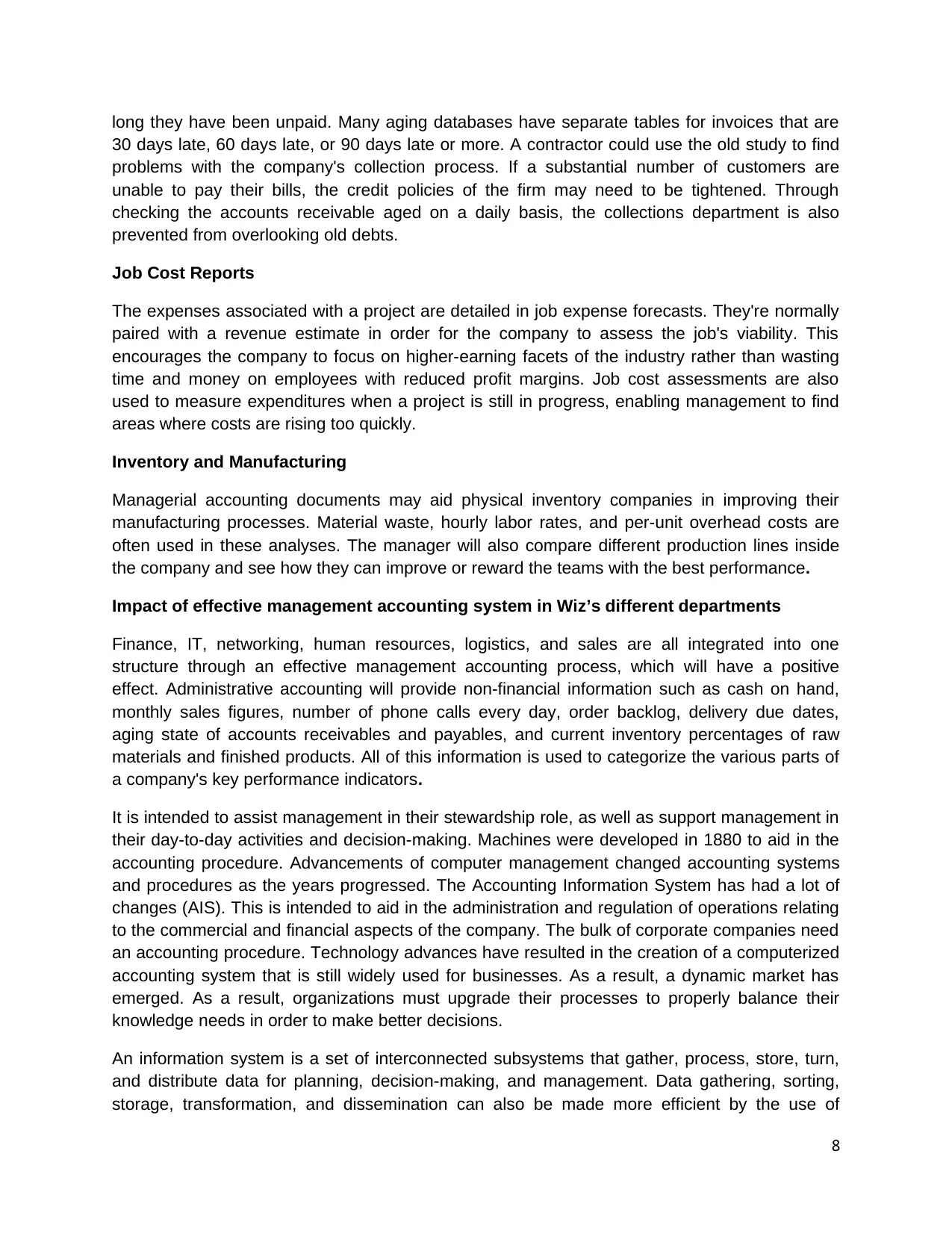
long they have been unpaid. Many aging databases have separate tables for invoices that are
30 days late, 60 days late, or 90 days late or more. A contractor could use the old study to find
problems with the company's collection process. If a substantial number of customers are
unable to pay their bills, the credit policies of the firm may need to be tightened. Through
checking the accounts receivable aged on a daily basis, the collections department is also
prevented from overlooking old debts.
Job Cost Reports
The expenses associated with a project are detailed in job expense forecasts. They're normally
paired with a revenue estimate in order for the company to assess the job's viability. This
encourages the company to focus on higher-earning facets of the industry rather than wasting
time and money on employees with reduced profit margins. Job cost assessments are also
used to measure expenditures when a project is still in progress, enabling management to find
areas where costs are rising too quickly.
Inventory and Manufacturing
Managerial accounting documents may aid physical inventory companies in improving their
manufacturing processes. Material waste, hourly labor rates, and per-unit overhead costs are
often used in these analyses. The manager will also compare different production lines inside
the company and see how they can improve or reward the teams with the best performance.
Impact of effective management accounting system in Wiz’s different departments
Finance, IT, networking, human resources, logistics, and sales are all integrated into one
structure through an effective management accounting process, which will have a positive
effect. Administrative accounting will provide non-financial information such as cash on hand,
monthly sales figures, number of phone calls every day, order backlog, delivery due dates,
aging state of accounts receivables and payables, and current inventory percentages of raw
materials and finished products. All of this information is used to categorize the various parts of
a company's key performance indicators.
It is intended to assist management in their stewardship role, as well as support management in
their day-to-day activities and decision-making. Machines were developed in 1880 to aid in the
accounting procedure. Advancements of computer management changed accounting systems
and procedures as the years progressed. The Accounting Information System has had a lot of
changes (AIS). This is intended to aid in the administration and regulation of operations relating
to the commercial and financial aspects of the company. The bulk of corporate companies need
an accounting procedure. Technology advances have resulted in the creation of a computerized
accounting system that is still widely used for businesses. As a result, a dynamic market has
emerged. As a result, organizations must upgrade their processes to properly balance their
knowledge needs in order to make better decisions.
An information system is a set of interconnected subsystems that gather, process, store, turn,
and distribute data for planning, decision-making, and management. Data gathering, sorting,
storage, transformation, and dissemination can also be made more efficient by the use of
8
30 days late, 60 days late, or 90 days late or more. A contractor could use the old study to find
problems with the company's collection process. If a substantial number of customers are
unable to pay their bills, the credit policies of the firm may need to be tightened. Through
checking the accounts receivable aged on a daily basis, the collections department is also
prevented from overlooking old debts.
Job Cost Reports
The expenses associated with a project are detailed in job expense forecasts. They're normally
paired with a revenue estimate in order for the company to assess the job's viability. This
encourages the company to focus on higher-earning facets of the industry rather than wasting
time and money on employees with reduced profit margins. Job cost assessments are also
used to measure expenditures when a project is still in progress, enabling management to find
areas where costs are rising too quickly.
Inventory and Manufacturing
Managerial accounting documents may aid physical inventory companies in improving their
manufacturing processes. Material waste, hourly labor rates, and per-unit overhead costs are
often used in these analyses. The manager will also compare different production lines inside
the company and see how they can improve or reward the teams with the best performance.
Impact of effective management accounting system in Wiz’s different departments
Finance, IT, networking, human resources, logistics, and sales are all integrated into one
structure through an effective management accounting process, which will have a positive
effect. Administrative accounting will provide non-financial information such as cash on hand,
monthly sales figures, number of phone calls every day, order backlog, delivery due dates,
aging state of accounts receivables and payables, and current inventory percentages of raw
materials and finished products. All of this information is used to categorize the various parts of
a company's key performance indicators.
It is intended to assist management in their stewardship role, as well as support management in
their day-to-day activities and decision-making. Machines were developed in 1880 to aid in the
accounting procedure. Advancements of computer management changed accounting systems
and procedures as the years progressed. The Accounting Information System has had a lot of
changes (AIS). This is intended to aid in the administration and regulation of operations relating
to the commercial and financial aspects of the company. The bulk of corporate companies need
an accounting procedure. Technology advances have resulted in the creation of a computerized
accounting system that is still widely used for businesses. As a result, a dynamic market has
emerged. As a result, organizations must upgrade their processes to properly balance their
knowledge needs in order to make better decisions.
An information system is a set of interconnected subsystems that gather, process, store, turn,
and distribute data for planning, decision-making, and management. Data gathering, sorting,
storage, transformation, and dissemination can also be made more efficient by the use of
8
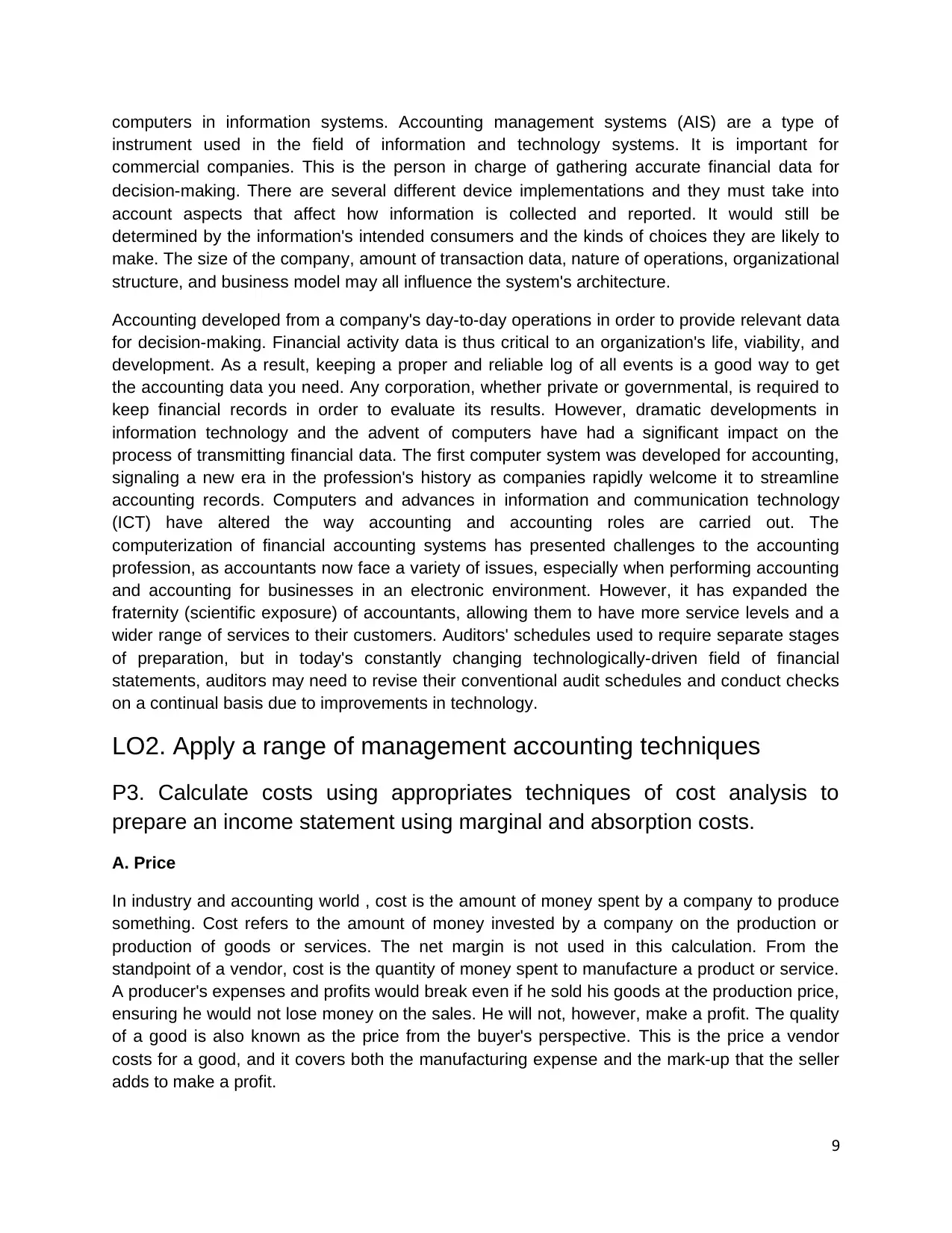
computers in information systems. Accounting management systems (AIS) are a type of
instrument used in the field of information and technology systems. It is important for
commercial companies. This is the person in charge of gathering accurate financial data for
decision-making. There are several different device implementations and they must take into
account aspects that affect how information is collected and reported. It would still be
determined by the information's intended consumers and the kinds of choices they are likely to
make. The size of the company, amount of transaction data, nature of operations, organizational
structure, and business model may all influence the system's architecture.
Accounting developed from a company's day-to-day operations in order to provide relevant data
for decision-making. Financial activity data is thus critical to an organization's life, viability, and
development. As a result, keeping a proper and reliable log of all events is a good way to get
the accounting data you need. Any corporation, whether private or governmental, is required to
keep financial records in order to evaluate its results. However, dramatic developments in
information technology and the advent of computers have had a significant impact on the
process of transmitting financial data. The first computer system was developed for accounting,
signaling a new era in the profession's history as companies rapidly welcome it to streamline
accounting records. Computers and advances in information and communication technology
(ICT) have altered the way accounting and accounting roles are carried out. The
computerization of financial accounting systems has presented challenges to the accounting
profession, as accountants now face a variety of issues, especially when performing accounting
and accounting for businesses in an electronic environment. However, it has expanded the
fraternity (scientific exposure) of accountants, allowing them to have more service levels and a
wider range of services to their customers. Auditors' schedules used to require separate stages
of preparation, but in today's constantly changing technologically-driven field of financial
statements, auditors may need to revise their conventional audit schedules and conduct checks
on a continual basis due to improvements in technology.
LO2. Apply a range of management accounting techniques
P3. Calculate costs using appropriates techniques of cost analysis to
prepare an income statement using marginal and absorption costs.
A. Price
In industry and accounting world , cost is the amount of money spent by a company to produce
something. Cost refers to the amount of money invested by a company on the production or
production of goods or services. The net margin is not used in this calculation. From the
standpoint of a vendor, cost is the quantity of money spent to manufacture a product or service.
A producer's expenses and profits would break even if he sold his goods at the production price,
ensuring he would not lose money on the sales. He will not, however, make a profit. The quality
of a good is also known as the price from the buyer's perspective. This is the price a vendor
costs for a good, and it covers both the manufacturing expense and the mark-up that the seller
adds to make a profit.
9
instrument used in the field of information and technology systems. It is important for
commercial companies. This is the person in charge of gathering accurate financial data for
decision-making. There are several different device implementations and they must take into
account aspects that affect how information is collected and reported. It would still be
determined by the information's intended consumers and the kinds of choices they are likely to
make. The size of the company, amount of transaction data, nature of operations, organizational
structure, and business model may all influence the system's architecture.
Accounting developed from a company's day-to-day operations in order to provide relevant data
for decision-making. Financial activity data is thus critical to an organization's life, viability, and
development. As a result, keeping a proper and reliable log of all events is a good way to get
the accounting data you need. Any corporation, whether private or governmental, is required to
keep financial records in order to evaluate its results. However, dramatic developments in
information technology and the advent of computers have had a significant impact on the
process of transmitting financial data. The first computer system was developed for accounting,
signaling a new era in the profession's history as companies rapidly welcome it to streamline
accounting records. Computers and advances in information and communication technology
(ICT) have altered the way accounting and accounting roles are carried out. The
computerization of financial accounting systems has presented challenges to the accounting
profession, as accountants now face a variety of issues, especially when performing accounting
and accounting for businesses in an electronic environment. However, it has expanded the
fraternity (scientific exposure) of accountants, allowing them to have more service levels and a
wider range of services to their customers. Auditors' schedules used to require separate stages
of preparation, but in today's constantly changing technologically-driven field of financial
statements, auditors may need to revise their conventional audit schedules and conduct checks
on a continual basis due to improvements in technology.
LO2. Apply a range of management accounting techniques
P3. Calculate costs using appropriates techniques of cost analysis to
prepare an income statement using marginal and absorption costs.
A. Price
In industry and accounting world , cost is the amount of money spent by a company to produce
something. Cost refers to the amount of money invested by a company on the production or
production of goods or services. The net margin is not used in this calculation. From the
standpoint of a vendor, cost is the quantity of money spent to manufacture a product or service.
A producer's expenses and profits would break even if he sold his goods at the production price,
ensuring he would not lose money on the sales. He will not, however, make a profit. The quality
of a good is also known as the price from the buyer's perspective. This is the price a vendor
costs for a good, and it covers both the manufacturing expense and the mark-up that the seller
adds to make a profit.
9
⊘ This is a preview!⊘
Do you want full access?
Subscribe today to unlock all pages.

Trusted by 1+ million students worldwide
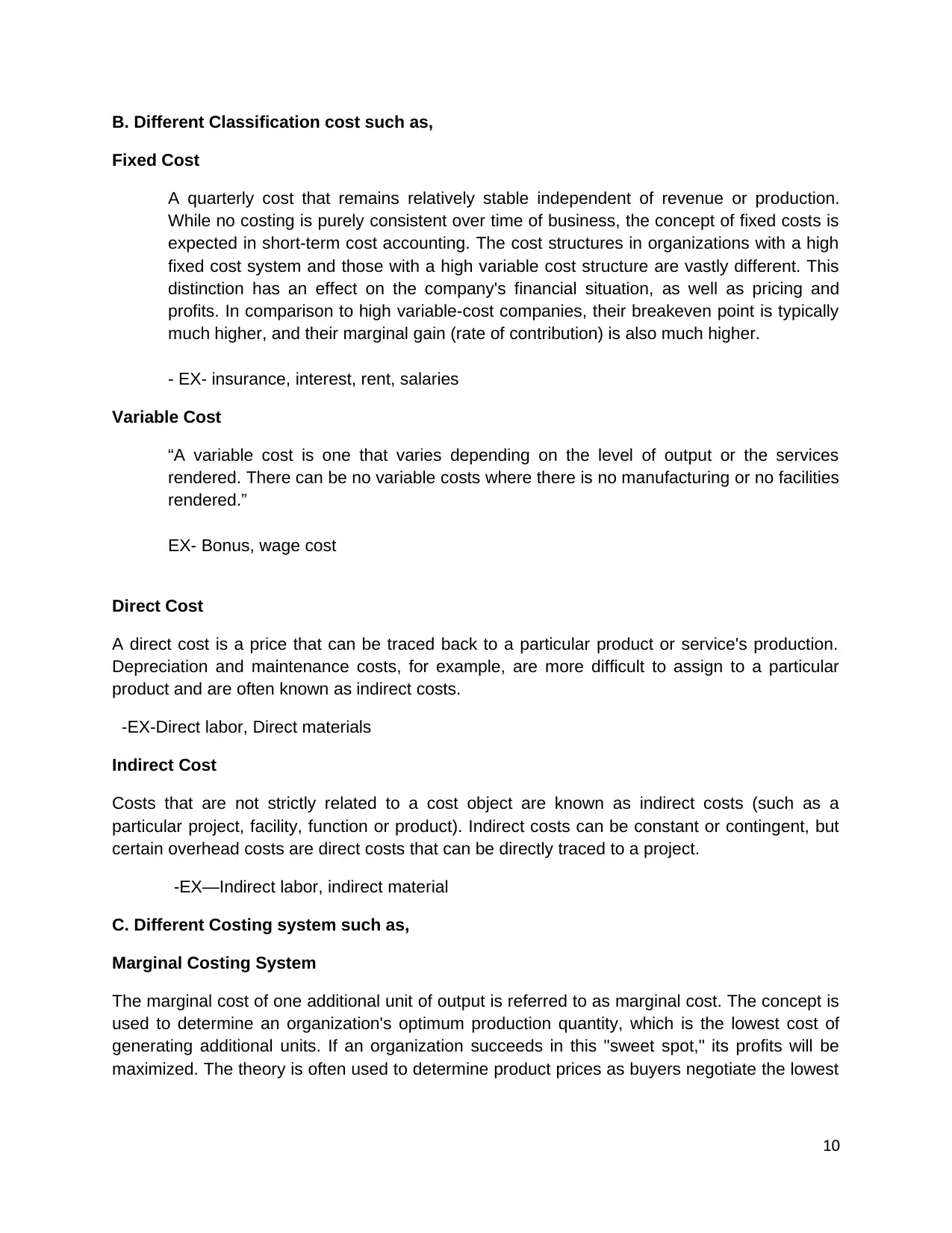
B. Different Classification cost such as,
Fixed Cost
A quarterly cost that remains relatively stable independent of revenue or production.
While no costing is purely consistent over time of business, the concept of fixed costs is
expected in short-term cost accounting. The cost structures in organizations with a high
fixed cost system and those with a high variable cost structure are vastly different. This
distinction has an effect on the company's financial situation, as well as pricing and
profits. In comparison to high variable-cost companies, their breakeven point is typically
much higher, and their marginal gain (rate of contribution) is also much higher.
- EX- insurance, interest, rent, salaries
Variable Cost
“A variable cost is one that varies depending on the level of output or the services
rendered. There can be no variable costs where there is no manufacturing or no facilities
rendered.”
EX- Bonus, wage cost
Direct Cost
A direct cost is a price that can be traced back to a particular product or service's production.
Depreciation and maintenance costs, for example, are more difficult to assign to a particular
product and are often known as indirect costs.
-EX-Direct labor, Direct materials
Indirect Cost
Costs that are not strictly related to a cost object are known as indirect costs (such as a
particular project, facility, function or product). Indirect costs can be constant or contingent, but
certain overhead costs are direct costs that can be directly traced to a project.
-EX—Indirect labor, indirect material
C. Different Costing system such as,
Marginal Costing System
The marginal cost of one additional unit of output is referred to as marginal cost. The concept is
used to determine an organization's optimum production quantity, which is the lowest cost of
generating additional units. If an organization succeeds in this "sweet spot," its profits will be
maximized. The theory is often used to determine product prices as buyers negotiate the lowest
10
Fixed Cost
A quarterly cost that remains relatively stable independent of revenue or production.
While no costing is purely consistent over time of business, the concept of fixed costs is
expected in short-term cost accounting. The cost structures in organizations with a high
fixed cost system and those with a high variable cost structure are vastly different. This
distinction has an effect on the company's financial situation, as well as pricing and
profits. In comparison to high variable-cost companies, their breakeven point is typically
much higher, and their marginal gain (rate of contribution) is also much higher.
- EX- insurance, interest, rent, salaries
Variable Cost
“A variable cost is one that varies depending on the level of output or the services
rendered. There can be no variable costs where there is no manufacturing or no facilities
rendered.”
EX- Bonus, wage cost
Direct Cost
A direct cost is a price that can be traced back to a particular product or service's production.
Depreciation and maintenance costs, for example, are more difficult to assign to a particular
product and are often known as indirect costs.
-EX-Direct labor, Direct materials
Indirect Cost
Costs that are not strictly related to a cost object are known as indirect costs (such as a
particular project, facility, function or product). Indirect costs can be constant or contingent, but
certain overhead costs are direct costs that can be directly traced to a project.
-EX—Indirect labor, indirect material
C. Different Costing system such as,
Marginal Costing System
The marginal cost of one additional unit of output is referred to as marginal cost. The concept is
used to determine an organization's optimum production quantity, which is the lowest cost of
generating additional units. If an organization succeeds in this "sweet spot," its profits will be
maximized. The theory is often used to determine product prices as buyers negotiate the lowest
10
Paraphrase This Document
Need a fresh take? Get an instant paraphrase of this document with our AI Paraphraser
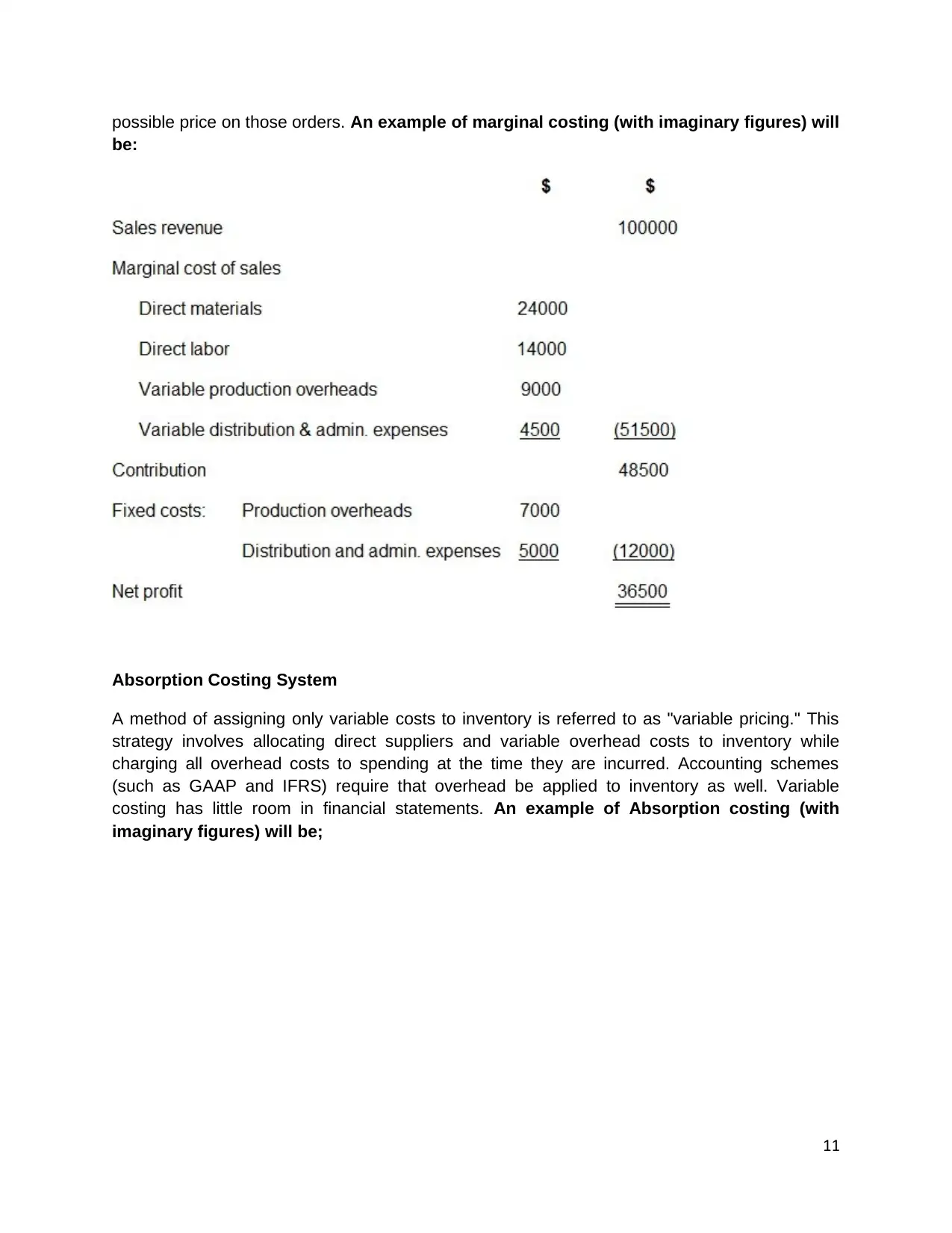
possible price on those orders. An example of marginal costing (with imaginary figures) will
be:
Absorption Costing System
A method of assigning only variable costs to inventory is referred to as "variable pricing." This
strategy involves allocating direct suppliers and variable overhead costs to inventory while
charging all overhead costs to spending at the time they are incurred. Accounting schemes
(such as GAAP and IFRS) require that overhead be applied to inventory as well. Variable
costing has little room in financial statements. An example of Absorption costing (with
imaginary figures) will be;
11
be:
Absorption Costing System
A method of assigning only variable costs to inventory is referred to as "variable pricing." This
strategy involves allocating direct suppliers and variable overhead costs to inventory while
charging all overhead costs to spending at the time they are incurred. Accounting schemes
(such as GAAP and IFRS) require that overhead be applied to inventory as well. Variable
costing has little room in financial statements. An example of Absorption costing (with
imaginary figures) will be;
11
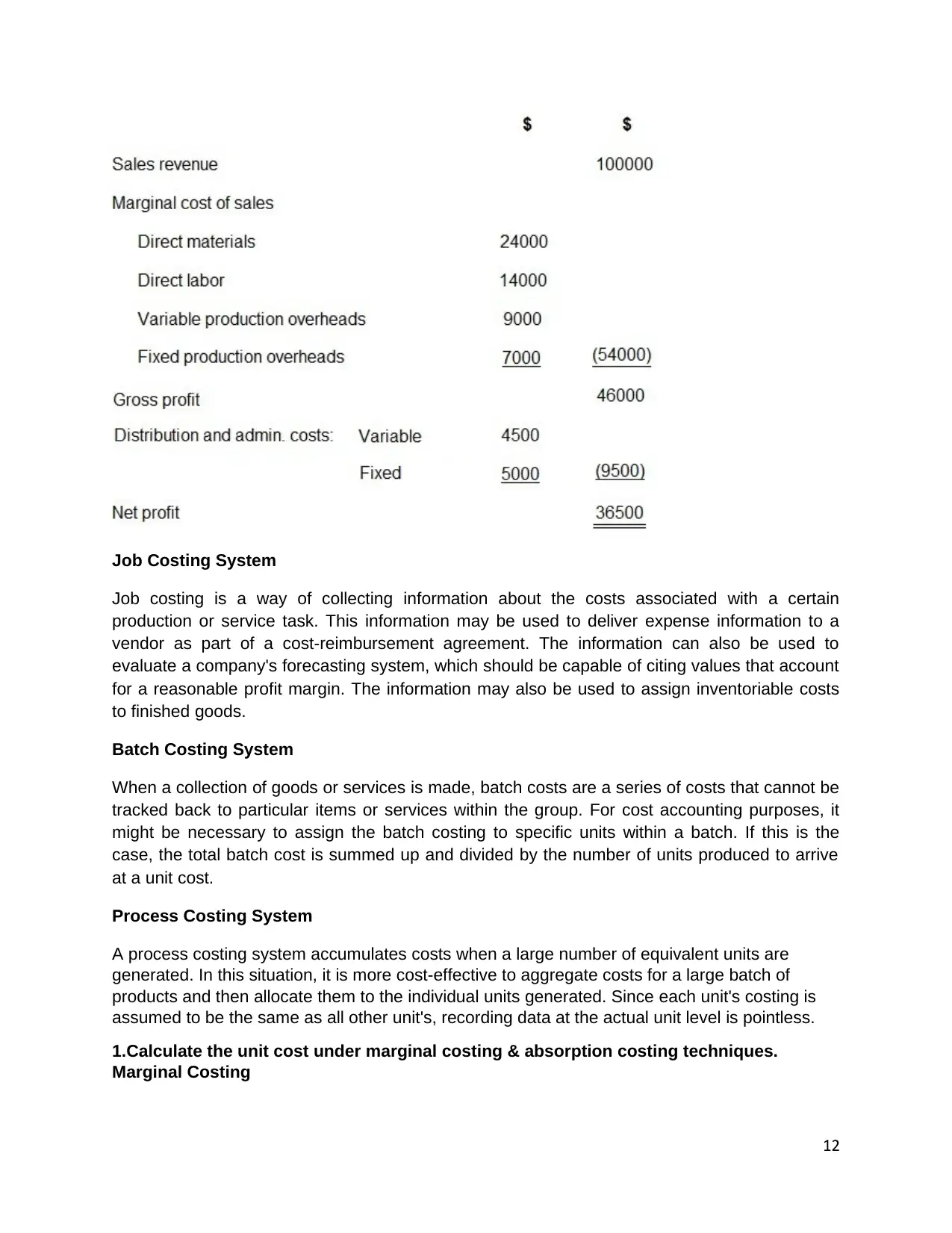
Job Costing System
Job costing is a way of collecting information about the costs associated with a certain
production or service task. This information may be used to deliver expense information to a
vendor as part of a cost-reimbursement agreement. The information can also be used to
evaluate a company's forecasting system, which should be capable of citing values that account
for a reasonable profit margin. The information may also be used to assign inventoriable costs
to finished goods.
Batch Costing System
When a collection of goods or services is made, batch costs are a series of costs that cannot be
tracked back to particular items or services within the group. For cost accounting purposes, it
might be necessary to assign the batch costing to specific units within a batch. If this is the
case, the total batch cost is summed up and divided by the number of units produced to arrive
at a unit cost.
Process Costing System
A process costing system accumulates costs when a large number of equivalent units are
generated. In this situation, it is more cost-effective to aggregate costs for a large batch of
products and then allocate them to the individual units generated. Since each unit's costing is
assumed to be the same as all other unit's, recording data at the actual unit level is pointless.
1.Calculate the unit cost under marginal costing & absorption costing techniques.
Marginal Costing
12
Job costing is a way of collecting information about the costs associated with a certain
production or service task. This information may be used to deliver expense information to a
vendor as part of a cost-reimbursement agreement. The information can also be used to
evaluate a company's forecasting system, which should be capable of citing values that account
for a reasonable profit margin. The information may also be used to assign inventoriable costs
to finished goods.
Batch Costing System
When a collection of goods or services is made, batch costs are a series of costs that cannot be
tracked back to particular items or services within the group. For cost accounting purposes, it
might be necessary to assign the batch costing to specific units within a batch. If this is the
case, the total batch cost is summed up and divided by the number of units produced to arrive
at a unit cost.
Process Costing System
A process costing system accumulates costs when a large number of equivalent units are
generated. In this situation, it is more cost-effective to aggregate costs for a large batch of
products and then allocate them to the individual units generated. Since each unit's costing is
assumed to be the same as all other unit's, recording data at the actual unit level is pointless.
1.Calculate the unit cost under marginal costing & absorption costing techniques.
Marginal Costing
12
⊘ This is a preview!⊘
Do you want full access?
Subscribe today to unlock all pages.

Trusted by 1+ million students worldwide
1 out of 45
Related Documents
Your All-in-One AI-Powered Toolkit for Academic Success.
+13062052269
info@desklib.com
Available 24*7 on WhatsApp / Email
![[object Object]](/_next/static/media/star-bottom.7253800d.svg)
Unlock your academic potential
Copyright © 2020–2025 A2Z Services. All Rights Reserved. Developed and managed by ZUCOL.




